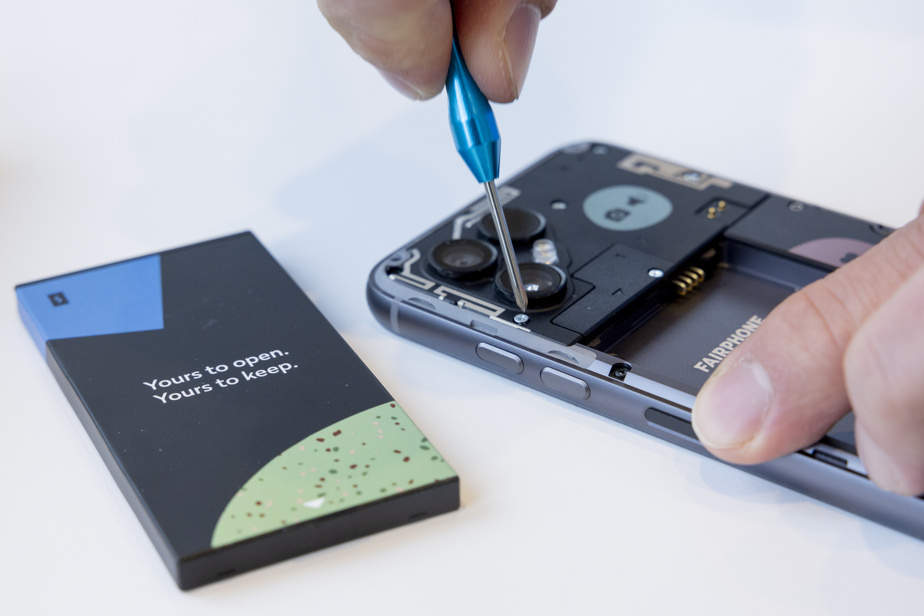Cell phone manufacturer Fairphone would like you not to buy its device!
Because repairing the phone you already own is much greener than replacing it.
The catch is that most cell phones are difficult to repair, if not downright impossible.
In contrast, the Fairphone phone is designed to be repaired and improved; the Dutch company also sells spare parts on its website and offers tutorials to help users do the repairs themselves.
With a simple screwdriver, it is easy to remove the various components of the Fairphone, which are neither glued nor soldered, as is the case in many other devices.

PHOTO MARCO CAMPANOZZI, THE PRESS
Fairphone’s phone is designed to be repaired and improved.
The Fairphone is also the only cell phone to score 10 out of 10 on the renowned collaborative website iFixit, whose mission is to promote the dissemination of knowledge on the repair of devices of all kinds.
Fair phone
Launched in 2013, the Fairphone was born out of an awareness campaign on the use in phones of minerals from conflict zones in the Democratic Republic of Congo, explains Anna Jopp, spokesperson for the company.
“Originally the goal wasn’t even to make a phone, it was just to bring attention to this problem,” she says. The reaction was strong, but people pointed out that there was no alternative on the market. »
The first model of Fairphone was therefore designed with the concern of using “fair” materials, but it was not repairable; the “modularity” came with the second model, launched in 2015, says Mme Jop.
It’s still impossible to produce a phone made from 100% sustainable and fair trade materials, says Fairphone, but the company is working to increase the proportion of the 14 main minerals in its devices that come from responsible sources, including gold, cobalt and tin.

PHOTO PROVIDED BY ANNA JOPP
Anna Jopp, spokesperson for Fairphone
Fairphone is now in its 4e model in 10 years of existence, which may seem contradictory for a company that encourages people not to replace their devices, but it is still much less than Apple and its 38 different iPhone models launched in 16 years.
Anna Jopp, spokesperson for Fairphone
“To allow people to keep their phone for a really long time, you also have to offer a phone that is up to date,” defends Anna Jopp, pointing out that Fairphone continues to offer technical support for its older models, unlike the major manufacturers.
Honest performance
From a technical point of view, the Fairphone 4 is a mid-range phone with decent performance, but sold at a rather high price for this category.
The Press used one on loan from the company in December and January and put it through Geekbench 5 benchmark tests, software that assesses processor speed and graphics processing capability.
It would be compared to a TCL 30 marketed in the summer of 2022 at a cost of $485, while you have to pay 579 euros ($842 CAN) for the Fairphone 4; other phones with higher performance also sell for less, such as the iPhone SE, Pixel 6a or Galaxy A53.
The photos delivered by the Fairphone 4 are acceptable, but singularly lacking in contrast and display washed-out colors.
However, the device’s software interface is impeccable, stable and well-finished: no jolts or undue delays when starting applications, except for demanding games or videoconferences where latency is rather obvious.
The materials used for the hull, classified IP54 for its resistance to dust and splashes of water, promise good durability.
A “beautiful solution”
The Fairphone is a “beautiful solution”, believes the analyst in reduction at the source of the environmental organization Équiterre Amélie Côté, who particularly welcomes the fact that the updates of the device have little effect on its efficiency, unlike others. other devices.
“It’s the problem of software obsolescence, where an update will unduly slow down the operation of a device, which can lead to its renewal,” she explains – a practice notably recognized by Apple in the past. .
Other companies should be forced to make their devices more easily repairable, says Ms.me Côté, pointing out that the smart phone is the electronic device that breaks most frequently.

PHOTO HUGO-SÉBASTIEN AUBERT, LA PRESSE ARCHIVES
Amélie Côté, source reduction analyst at Équiterre
It takes an ambitious legislative framework, based on France’s right to compensation, because we can’t just count on the industry to self-regulate.
Amélie Côté, source reduction analyst at Équiterre
The Fairphone isn’t sold in North America yet, but it’s on the company’s “wish list,” still too small to supply the North American market and offer customer service there, Anna says. Jop.
The company is well aware that Fairphones are used in North America, but points out that the device is not optimized for North American frequencies and may not work in some locations.
Fairphone or not, another way to reduce the carbon footprint of your cell phone is to buy a refurbished device, an increasingly widespread practice, underlines Amélie Côté.
Learn more
-
- 70kg
- Amount of resources required to manufacture a cell phone, approximately 600 times its weight
source: French Environment and Energy Management Agency
- 78%
- Proportion of the total carbon footprint of a phone that can represent the stage of its manufacture
source: French Environment and Energy Management Agency
-
- 3%
- Proportion of cell phones recovered in Quebec in 2021
source: Quebec Society for Recovery and Recycling (Recyc-Québec)
